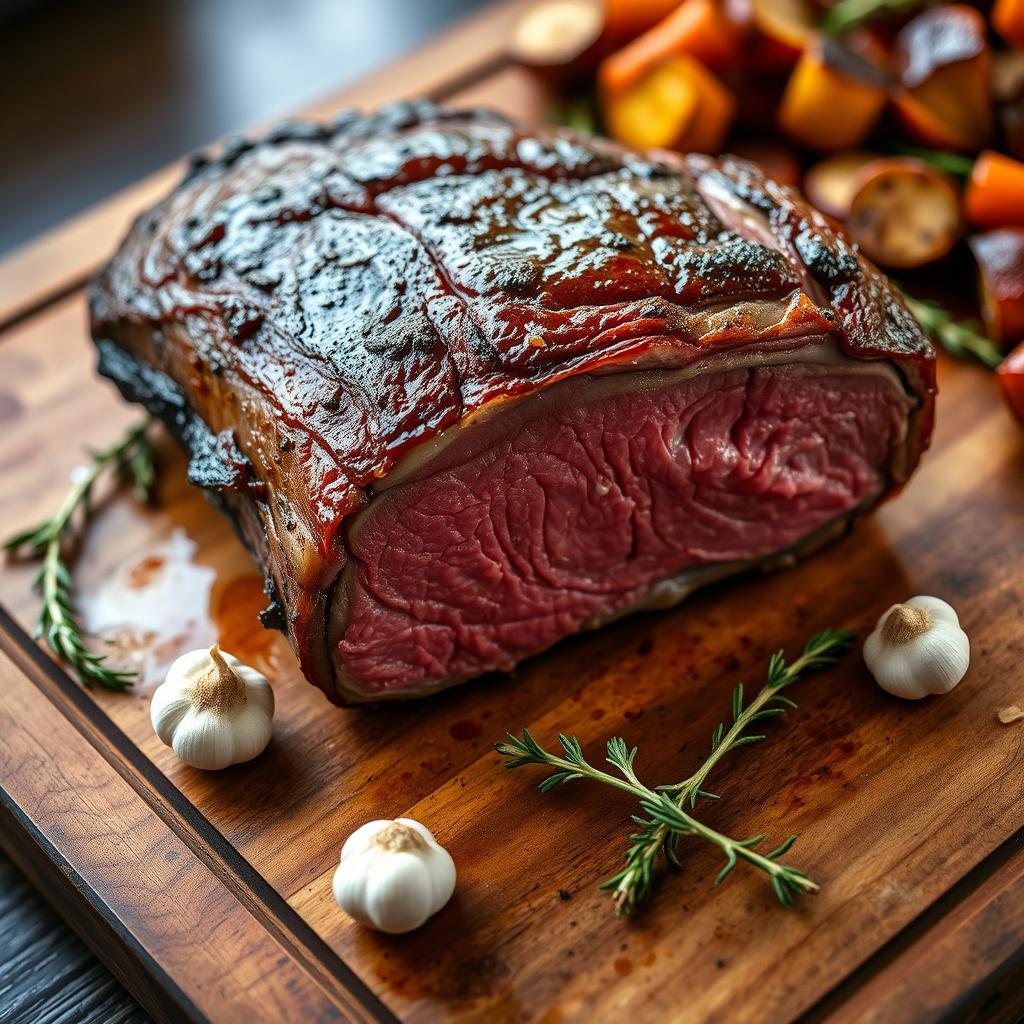Did you know over 70% of chefs favor the ribeye roast for big dinners? This fact highlights the ribeye’s top-notch quality. It makes it the star of any special meal.
We will show you how to cook a perfect ribeye roast. Picture biting into a juicy, flavor-packed ribeye. It feels like a celebration of taste. These tips are for any occasion, ensuring a delicious ribeye roast every time.
Are you ready to learn how to make a delicious ribeye roast? Let’s begin!
Introduction to the Perfect Ribeye Roast
The ribeye roast is often seen as the crown jewel of beef cuts. It is known for its rich marbling and remarkable tenderness. This cut makes any meal a gourmet experience. Knowing about the ribeye helps you see why it’s top among roasts.
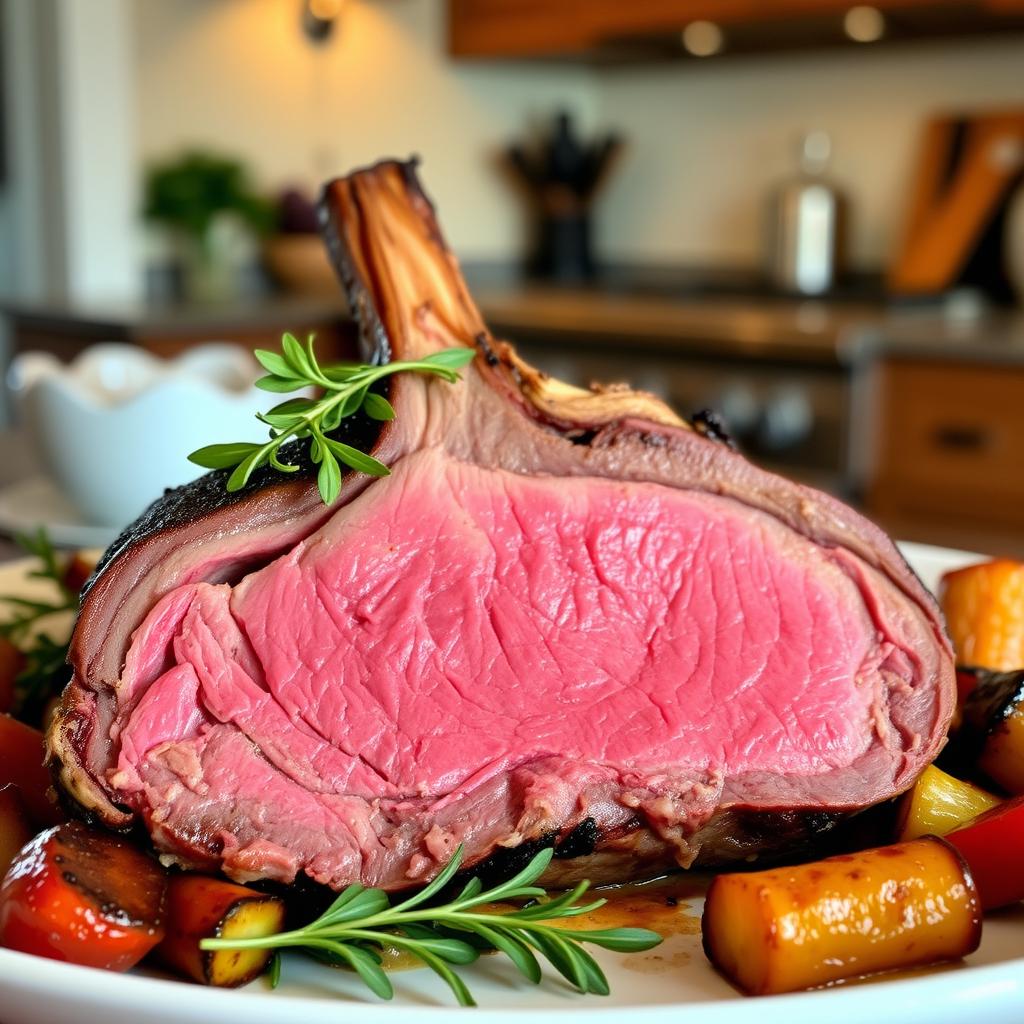
What Makes Ribeye Roast Special
Prime ribeye is famous for its marbling. The fat weaves through the meat, making every bite flavorful and juicy. This fat makes the meat moist and tender. It’s a favorite because of its unique mix of lean meat and fat. It offers a dining experience like no other.
Why Choose Ribeye for Your Roast
Choosing ribeye for a roast has many benefits. It’s versatile, so you can roast it how you like, rare or well-done. The flavor is strong, so it needs only a little seasoning. Prime ribeye always brings consistent and excellent results. It makes gatherings memorable with its taste and quality.
Choosing the Best Ribeye Cut
Choosing the right ribeye cut improves your cooking. It’s vital to understand the differences between Prime and Choice. These differences impact the meat’s taste, tenderness, and juiciness.
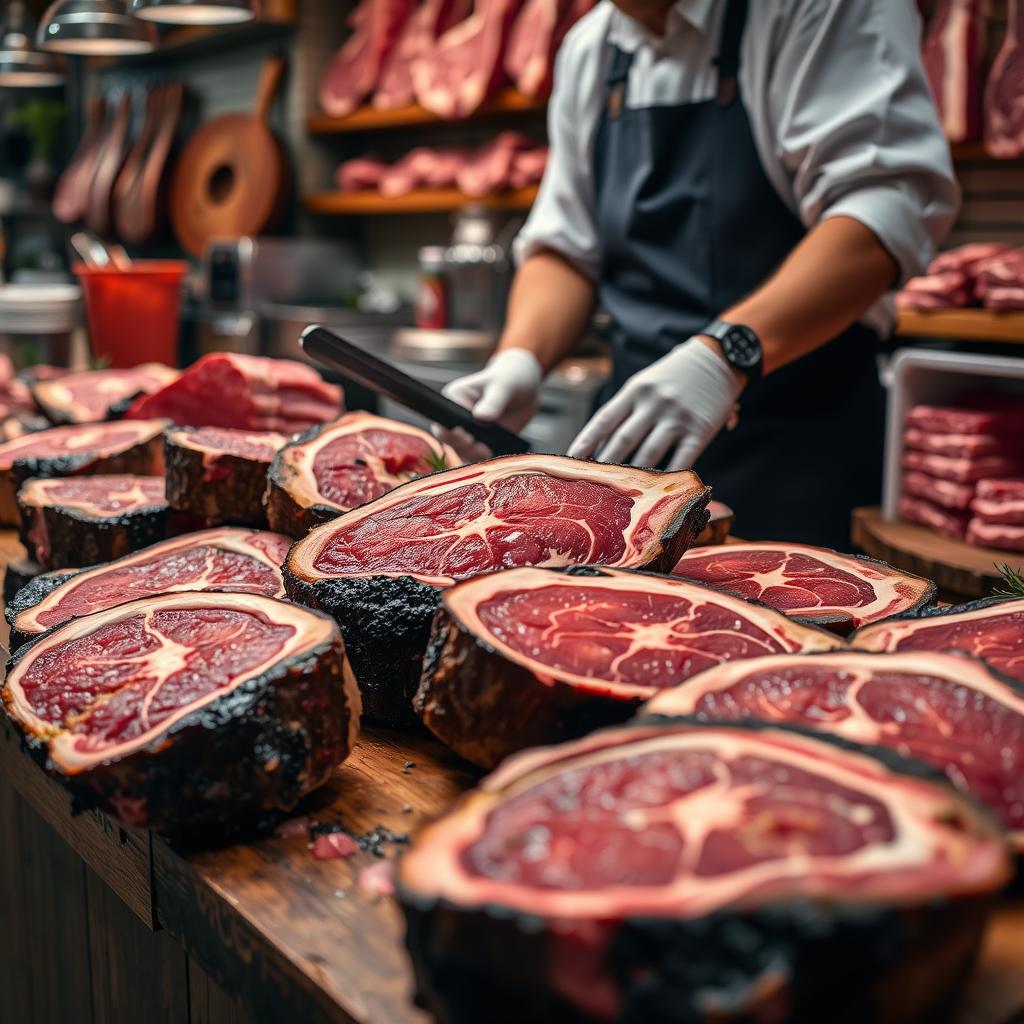
It’s important to look at the meat grading when picking a ribeye. Prime ribeye is top-notch, with superb marbling that enhances its flavor and softness. Choice ribeye offers a great mix of taste and value for money. But, Select grade is more affordable yet less soft and tasty.
Butcher’s advice on ribeye points out marbling’s importance. You should look for fine, well-spread white fat in the meat. This fat makes the ribeye moist and tasty. Also, ensure the meat is a vibrant cherry-red color to show it’s fresh.
Asking a skilled butcher can give more help in picking the best ribeye. They can explain what to look for in texture and fat distribution. This improves the quality of your ribeye roast. Make sure to buy your meat from trusted sellers to get the top cut.
Essential Ingredients for Juicy Ribeye Roast
To make a juicy ribeye roast, start with the right things. You’ll need high-quality meat and a mix of spices and herbs. This mix will make your ribeye amazing.
Quality Meat Selection
Look for marbling when picking out a ribeye roast. Marbling means there are fine lines of fat in the meat. This makes it tender and tasty. The meat should be bright red and firm, showing it’s fresh.
Choose USDA Prime or Choice grades for the best quality. Buy from a trusted butcher to get the best and freshest cut.
Complementary Spices and Herbs
The right seasonings are important for your ribeye roast. Use garlic powder, black pepper, and paprika. These spices bring out the meat’s juiciness. Also, add herbs for ribeye roast like rosemary, thyme, and oregano. They add flavor and a nice smell.
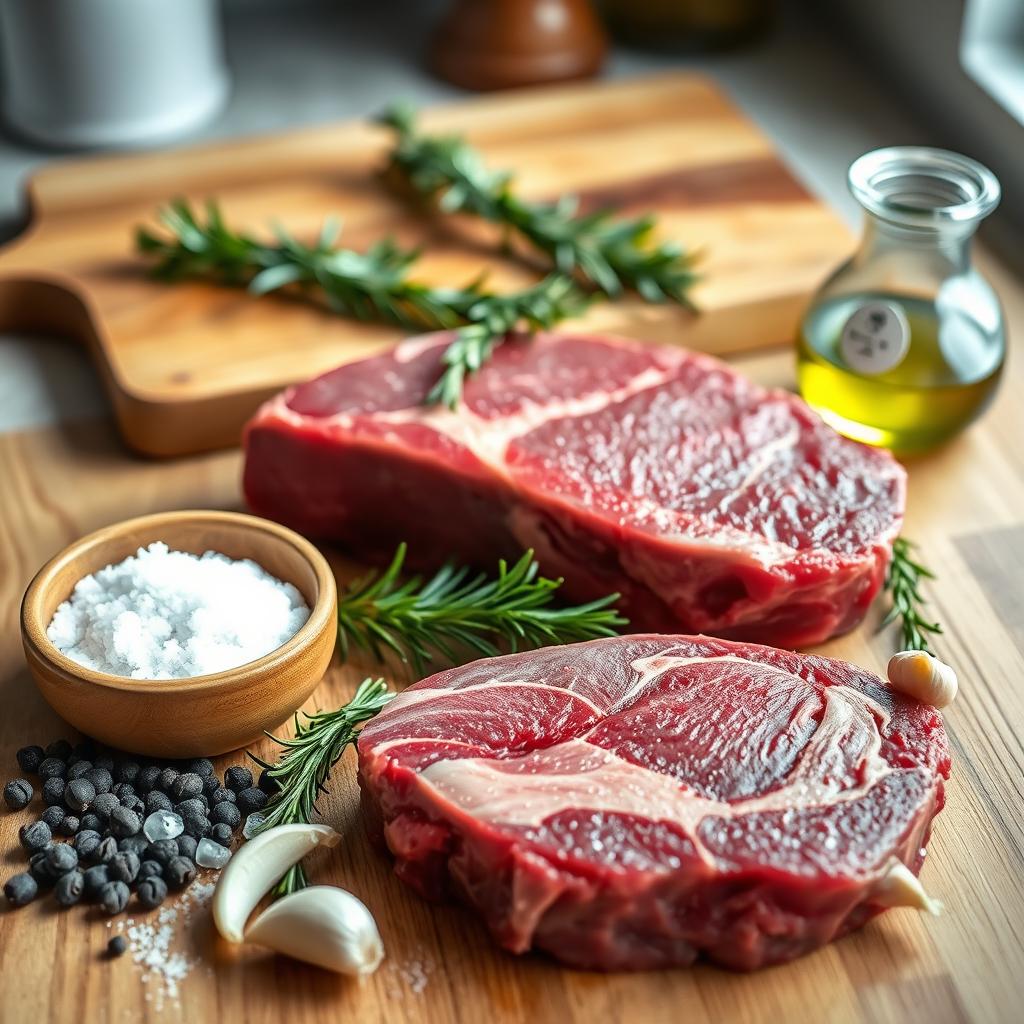
It’s key to mix your seasonings well. Try mixing garlic and onion powder, smoked paprika, and dried thyme. Salt the meat well to help it absorb flavors. For something special, add fresh rosemary and lemon zest.
Using the right mix of these ribeye roast ingredients will make your roast unforgettable.
Preparing Your Ribeye Roast
To make your ribeye roast cook evenly and taste great, proper prep is key. Start by putting the ribeye on a clean spot for trimming. Trim the ribeye well, taking off extra fat but keep enough for flavor.
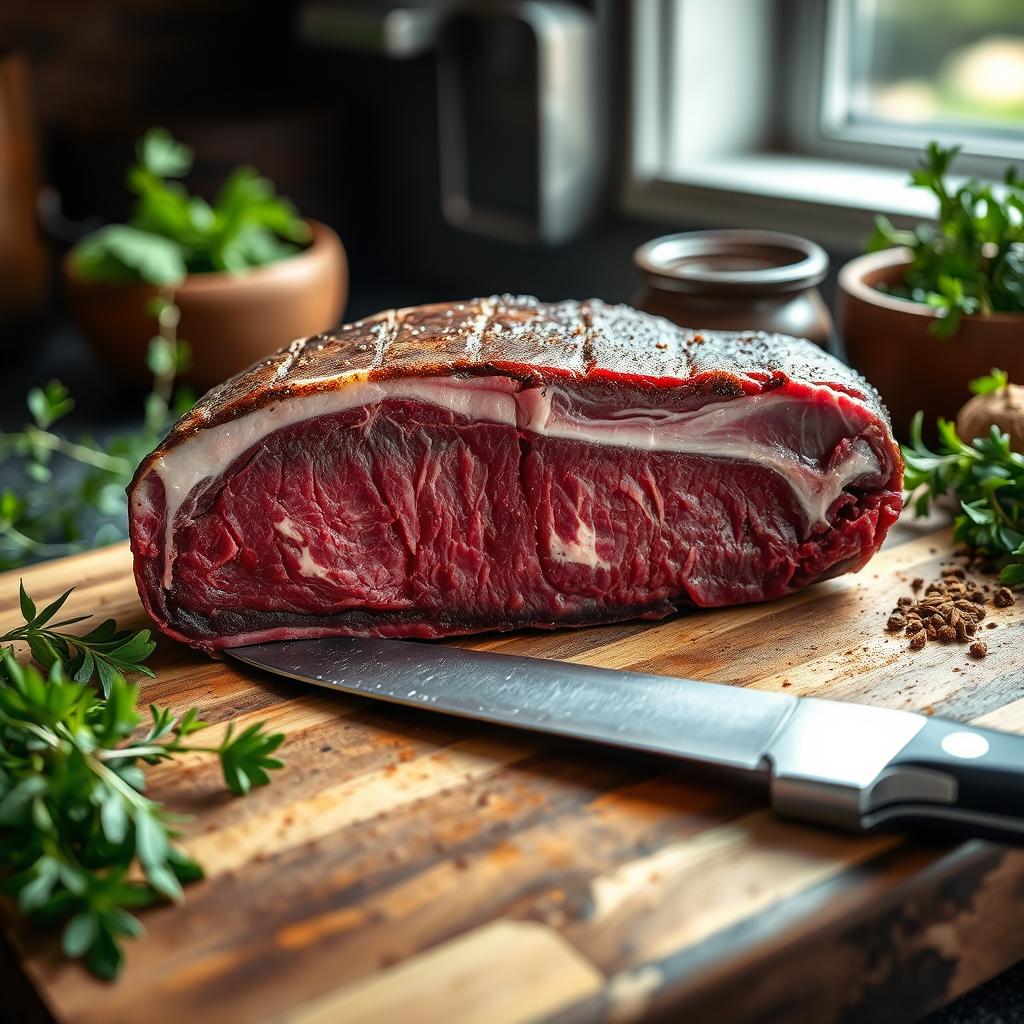
Then, don’t forget about tying the ribeye. It’s a step many skip but it’s important. Tie the roast with kitchen twine at several places. This keeps its shape and cooks it evenly.
Before cooking, let your ribeye warm to room temperature. This makes cooking more even and avoids undercooked parts. Stick to these steps for a perfect ribeye roast:
- Trim the ribeye carefully to get the right mix of flavor and texture.
- Tie the ribeye for even cooking and to look good.
- Warm the meat to room temperature for consistent results.
Now that you’ve prepped, you’re all set to cook an amazing ribeye roast. This will be the highlight of your meal.
Marinating Tips for Extra Flavor
Make your ribeye roast stand out with expert marinating tips. These tips inject your meat with amazing flavor and tenderness. Aim for a savory, spicy, or herb-infused profile for an unforgettable ribeye experience.
Best Marinades for Ribeye Roast
Choosing the right marinade is key for a delicious ribeye roast. Consider these top marinades:
- Garlic and Herb Marinade: A classic mix of minced garlic, rosemary, thyme, olive oil, and lemon juice.
- Asian-Inspired Marinade: A mix of soy sauce, ginger, garlic, brown sugar, and sesame oil adds an exotic twist.
- Spicy Cajun Marinade: A spicy blend with paprika, cayenne, garlic powder, onion powder, and Worcestershire sauce.
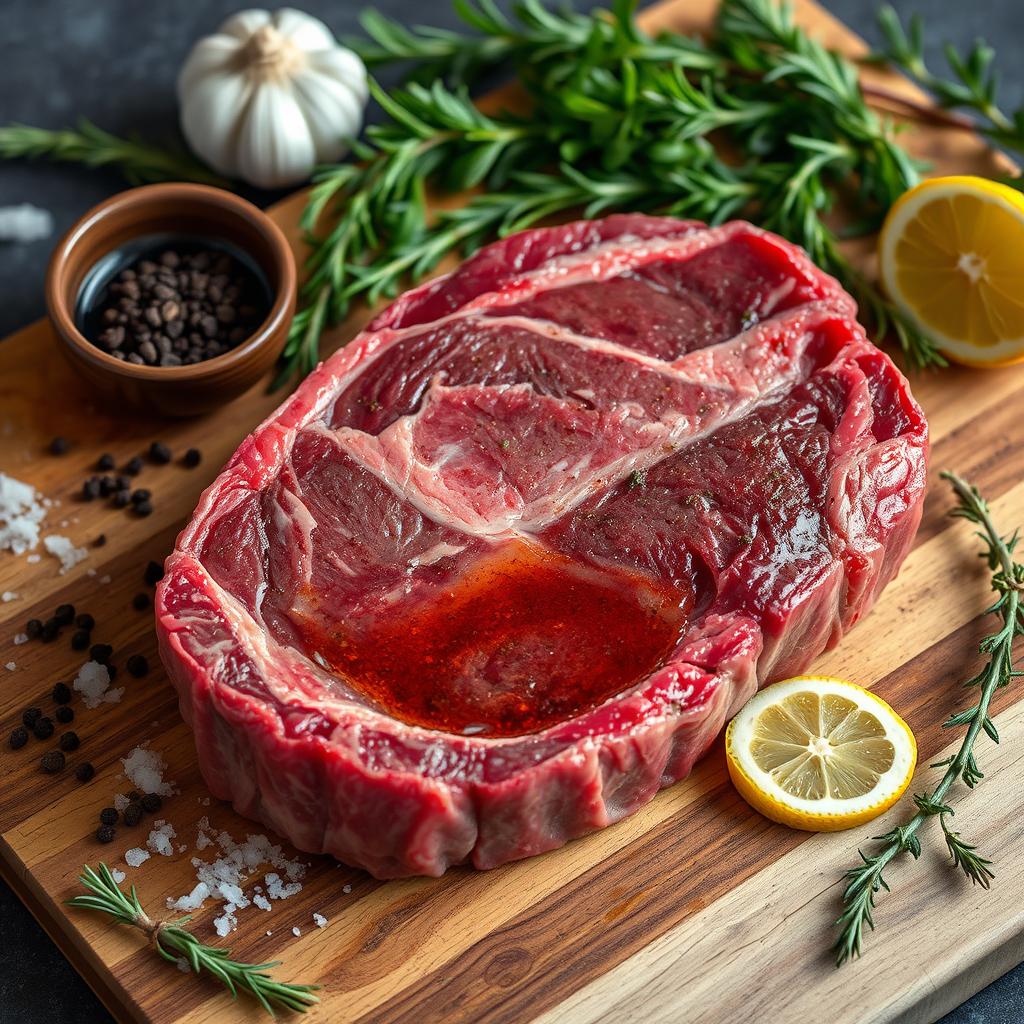
Marinating Duration and Techniques
Knowing how long to marinate your ribeye is crucial. Here’s how to do it right:
- Duration: Marinate the ribeye roast for a minimum of 4 hours, but letting it sit overnight is best.
- Technique: Use a resealable plastic bag or a shallow dish for marinating. Make sure the marinade covers the roast. Turn the roast now and then to spread the flavors.
- Pat Dry: Before cooking, pat the roast dry to get rid of extra marinade. This is important for a great sear.
Using these marinating tips will help you make a ribeye roast that’s both flavorful and memorable.
Perfect Ribeye Roast Recipe: Cooking Instructions
Making a delicious ribeye roast requires careful prep and cooking. Follow these detailed steps. They’ll help you get your ribeye roast soft, juicy, and full of flavor.
Oven Preparation and Preheating
First, get your oven ready to cook. Heat your oven to the right temperature for ribeye, which is about 450°F. Let it warm up completely. A properly heated oven cooks the ribeye roast evenly.
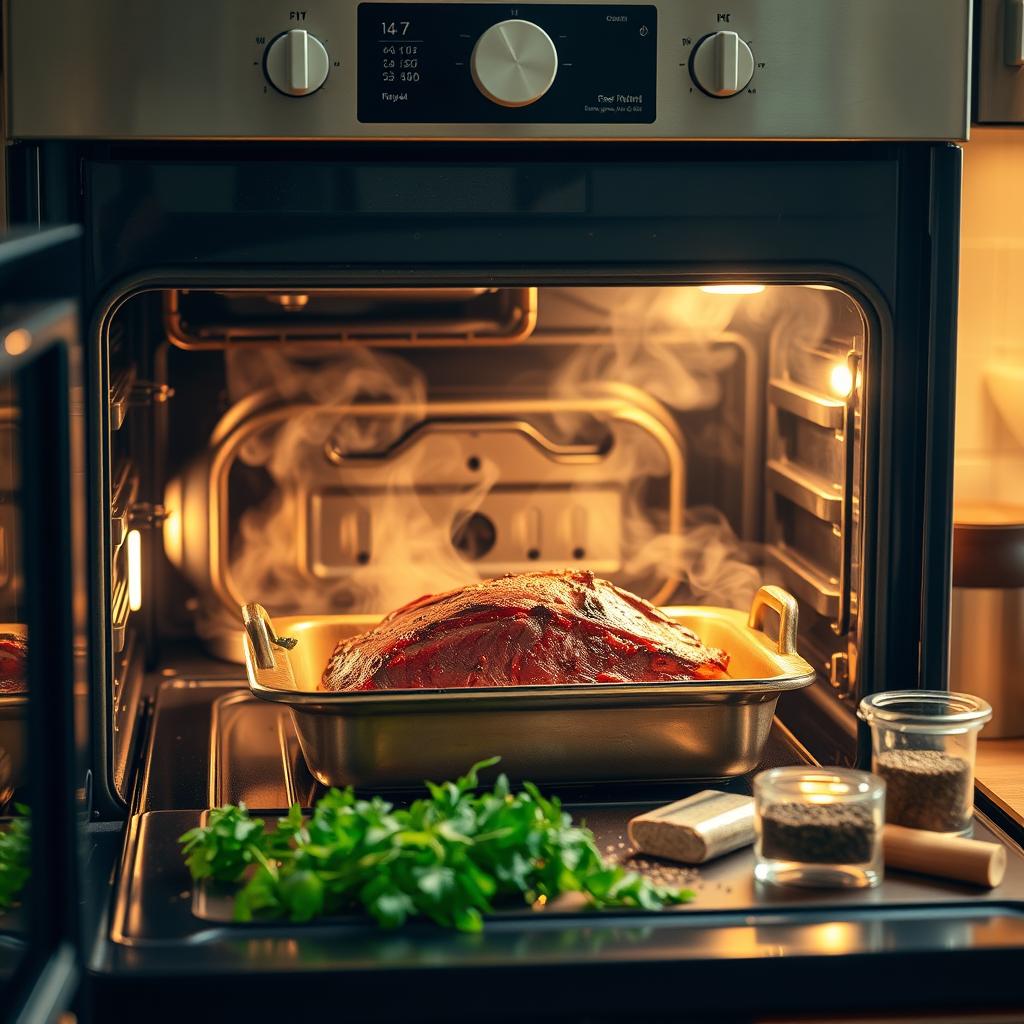
While waiting, put a roasting rack in a big roasting pan. This lets air move all around the ribeye, browning it nicely on every side.
Ideal Cooking Temperatures
With the oven ready, it’s time to think about how well done you want your ribeye. Here’s a quick guide:
- Rare: Around 125°F inside
- Medium-rare: Around 135°F inside
- Medium: Around 145°F inside
- Medium-well: Around 155°F inside
- Well-done: Around 160°F inside
Stick a meat thermometer in the thickest part of the ribeye to keep an eye on its temperature. Adjust your oven as needed to keep the right temperature.
With these precise instructions, you’ll make a ribeye roast that’s perfect every time. Your guests will be amazed.
Roasting Times for Different Levels of Doneness
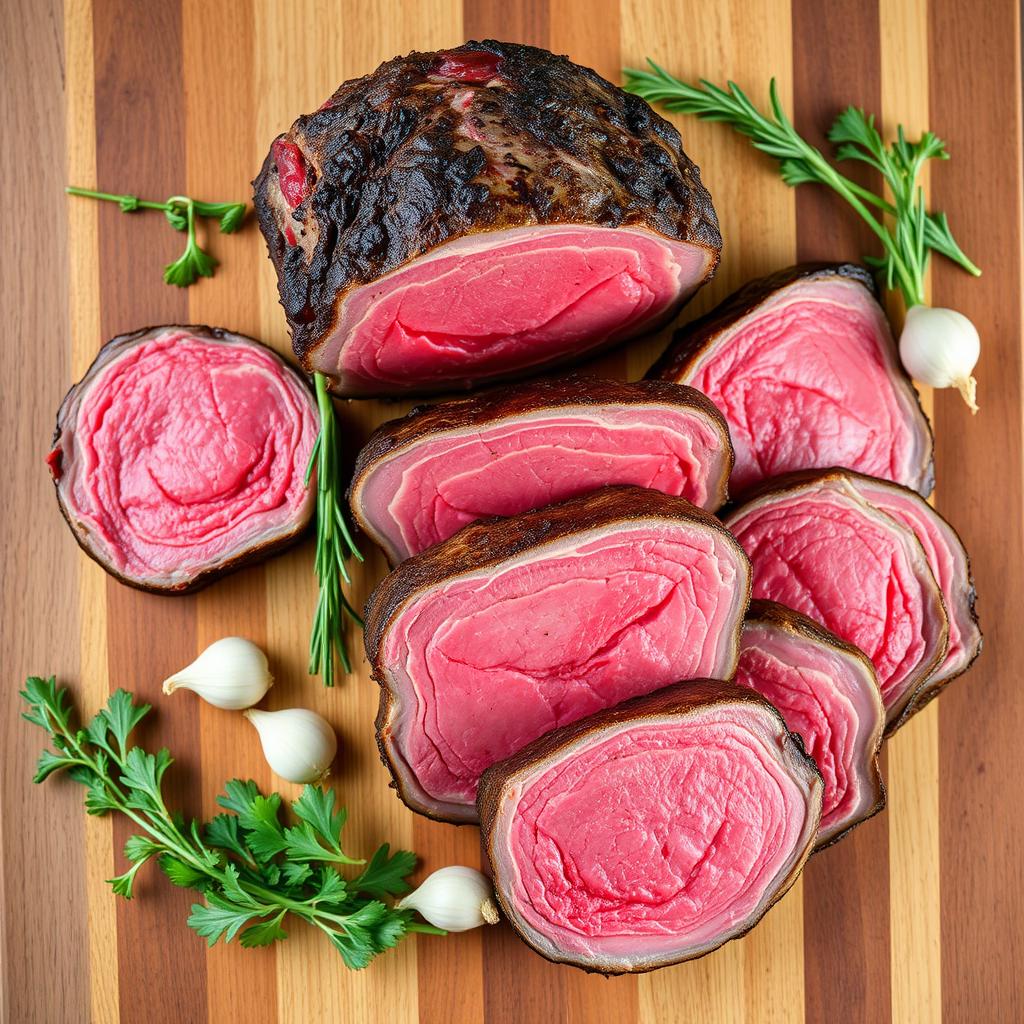
Getting your ribeye roast just right depends on knowing how to cook it. We’ll show you how to nail the perfect level of doneness. This guide covers everything from rare to well-done.
Rare to Medium Rare Roasting Guide
Like your ribeye juicy with a pink center? Then aim for rare to medium rare. For this, ribeye temperatures should be between 125°F to 135°F. Start by roasting at 450°F for 15 minutes. Then drop the heat to 325°F and keep roasting.
- Rare: 15-20 minutes per pound, or until it hits 125°F
- Medium Rare: 20-25 minutes per pound, or until you reach 130°F to 135°F
Use a meat thermometer to check the temp accurately. This makes sure your roast is just how you want it, without overcooking.
Medium to Well-Done Roasting Guide
If you like your ribeye firmer with no pink, aim for medium to well-done. The temps for these levels range from 140°F to 160°F. Start with a high-heat sear at 450°F for 15 minutes. Then lower to 325°F and keep roasting.
- Medium: 25-30 minutes per pound, or until it reaches 140°F to 145°F
- Medium Well: 30-35 minutes per pound, or until it’s 150°F to 155°F
- Well-Done: 35-40 minutes per pound or until you hit 160°F
Using a thermometer and following these times will ensure your ribeye roast is perfect. This guarantees a tasty and enjoyable meal.
How to Achieve a Perfect Crust
Creating a perfect ribeye roast crust requires skill and knowledge. We’ll explore key steps for a mouthwatering result.
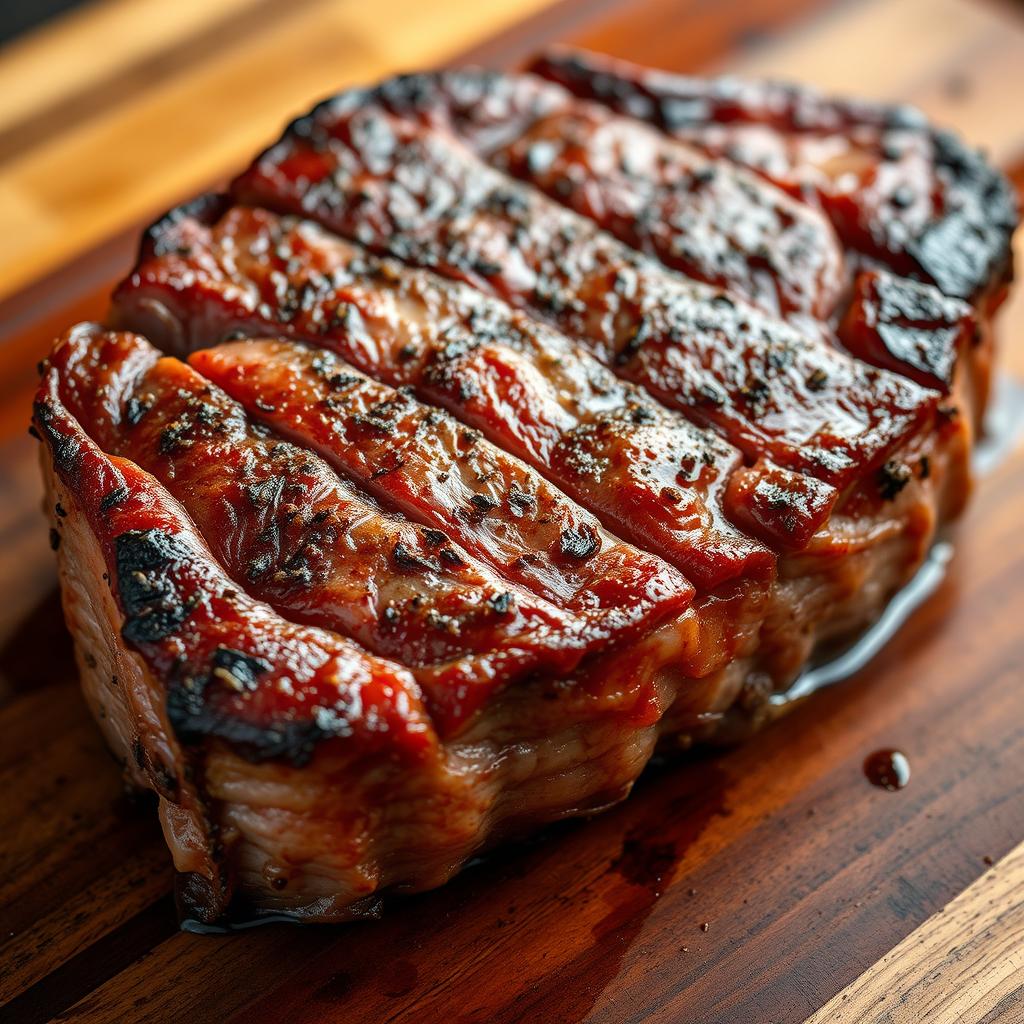
Sealing in the Juices
Sealing in juices is vital for a perfect crust. It can be done using two main methods:
- Searing the Ribeye: Begin by heating your pan until it’s very hot. Sear the ribeye on each side for a few minutes. This seals in the juices, keeping the roast moist and flavorful.
- Using a Salt Crust: Cover your ribeye with coarse salt before roasting. A salt crust keeps the juices in and adds flavor during cooking.
Finishing Touch Techniques
To perfect the ribeye roast crust, use these techniques:
- Butter Basting: Halfway through cooking, baste the ribeye with melted butter and herbs. This adds flavor and helps form a golden crust.
- High-Heat Finish: Increase the oven temperature in the last minutes of roasting. This makes the crust extra crispy. A quick broil can also achieve this if you’re in a hurry.
Follow these strategies to craft a ribeye crust that looks great and tastes amazing. Every bite will offer savory flavors and perfect juiciness.
Resting Your Ribeye Roast
After you cook it perfectly, you must rest your ribeye roast. This is crucial to get that juicy, flavorful taste. Letting it rest spreads the juices out evenly. This makes sure every slice stays moist and tender.
So, why rest your ribeye roast? The reason behind this is simple but works great. When you take your roast out, it still gets a bit hotter inside. This extra heat finishes cooking it on the inside while the outside starts to cool down. If you cut it too soon, all the juices will run out, and your meat will be dry. So, it’s very important to include rest time in your plan.
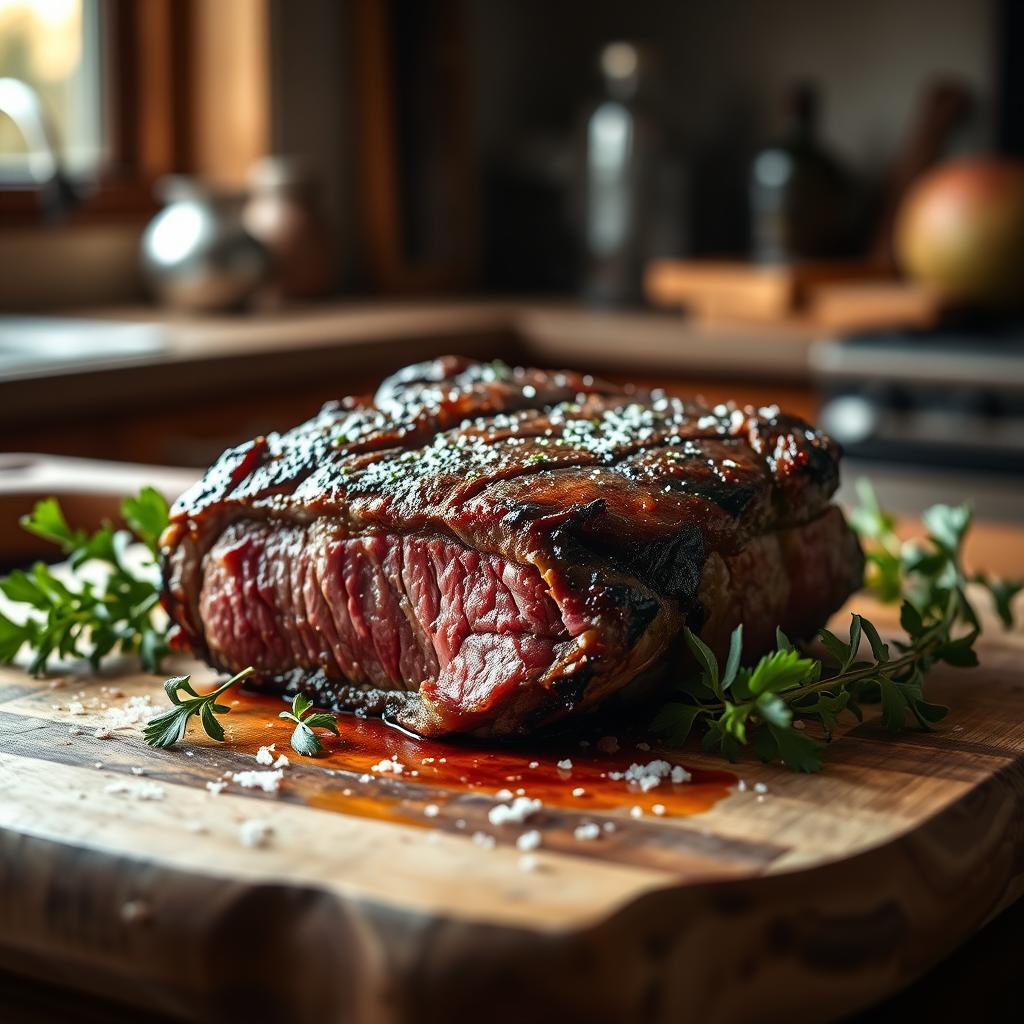
How long should you rest your ribeye? It depends on its size. A normal ribeye roast needs about 15-20 minutes. Bigger roasts might need up to 30 minutes. This makes sure all the juices settle properly. To keep it warm, you can lightly cover it with aluminum foil. This keeps the heat in without ruining the crust.
Here are some tips to get the most out of resting your ribeye:
- Loosely tent with foil: This keeps it warm without making the crust soggy.
- Rest on a cutting board: It helps spread the heat evenly and stops more cooking.
- Monitor with a meat thermometer: Make sure the temperature stays steady while it rests.
By making sure you rest your ribeye just right, you’ll make your roast even better. Every bite will be amazing. Just remember, being patient is the secret to those delicious flavors.
Carving Techniques for Ribeye Roast
Getting the hang of carving a ribeye roast is key to enjoying its juicy, flavorful best. With the proper tools and steps, you’ll carve like a pro in no time.
Tools You Will Need
You’ll need some important tools for slicing ribeye perfectly:
- Carving knife: A long, sharp knife for clean cuts.
- Carving fork: Keeps the roast steady while you slice.
- Cutting board: A stable surface with grooves for juices.
- Meat thermometer: Ensures the roast is cooked just right.
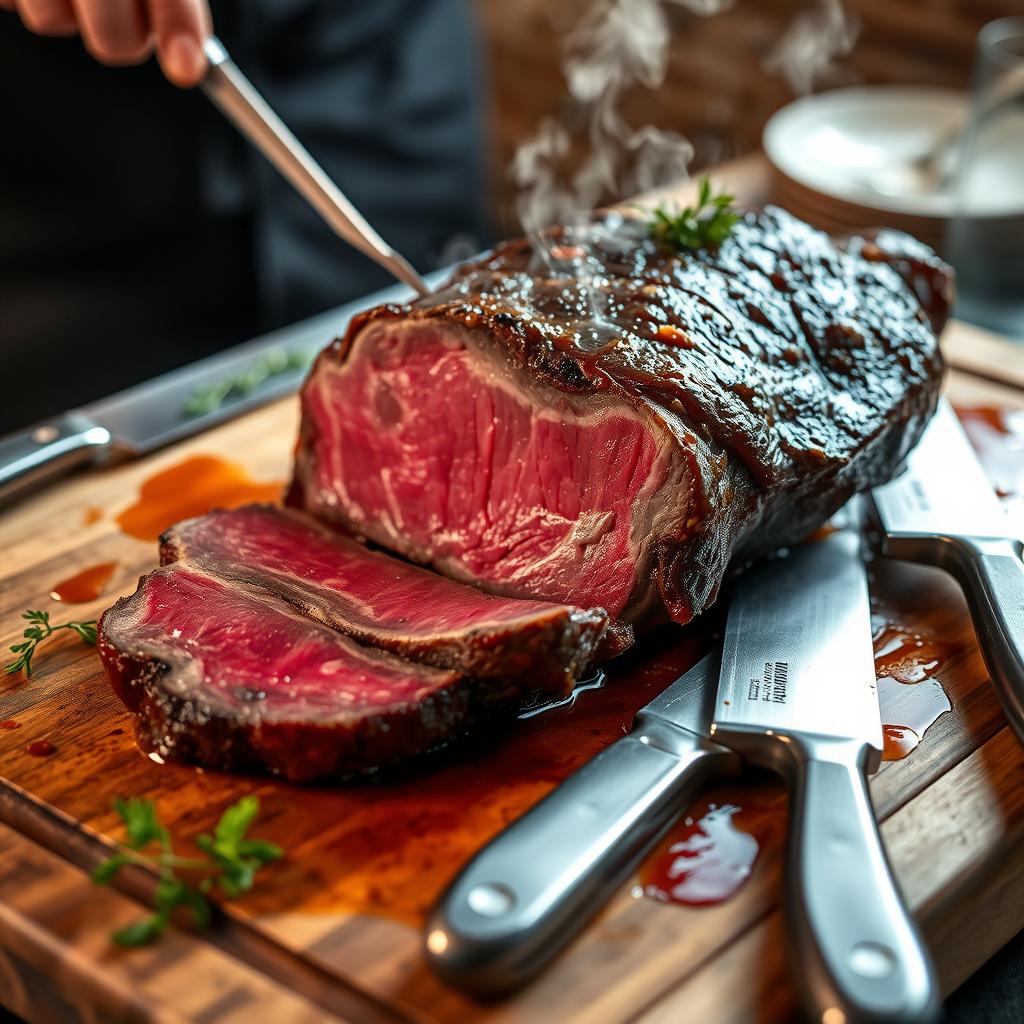
Step-by-Step Carving Instructions
- Rest the Roast: Let the ribeye rest for 15-20 minutes before starting. This keeps it juicy and makes slicing easier.
- Identify the Grain: Look at the grain direction in the meat. Cut against the grain for tender slices.
- Steady the Roast with a Fork: Use a carving fork to keep the meat in place.
- Make the Initial Cut: Start your cut at one end of the roast. Aim for smooth, even cuts to keep it looking good.
- Continue Slicing: Keep slicing against the grain. Make your slices about 1/4 to 1/2 inch thick, based on your preference.
- Serve Immediately: Place your perfectly carved slices on a platter. Enjoy them warm for the best flavor.
Follow these steps for a confidence boost in carving ribeye roast. It will look and taste amazing, making dining a pleasure for everyone.
Gravy and Sauce Pairings
Boosting the taste of your ribeye roast is simple with the right gravy and sauces. Trying out different combinations can enhance your meal. It adds depth and makes dining more enjoyable.
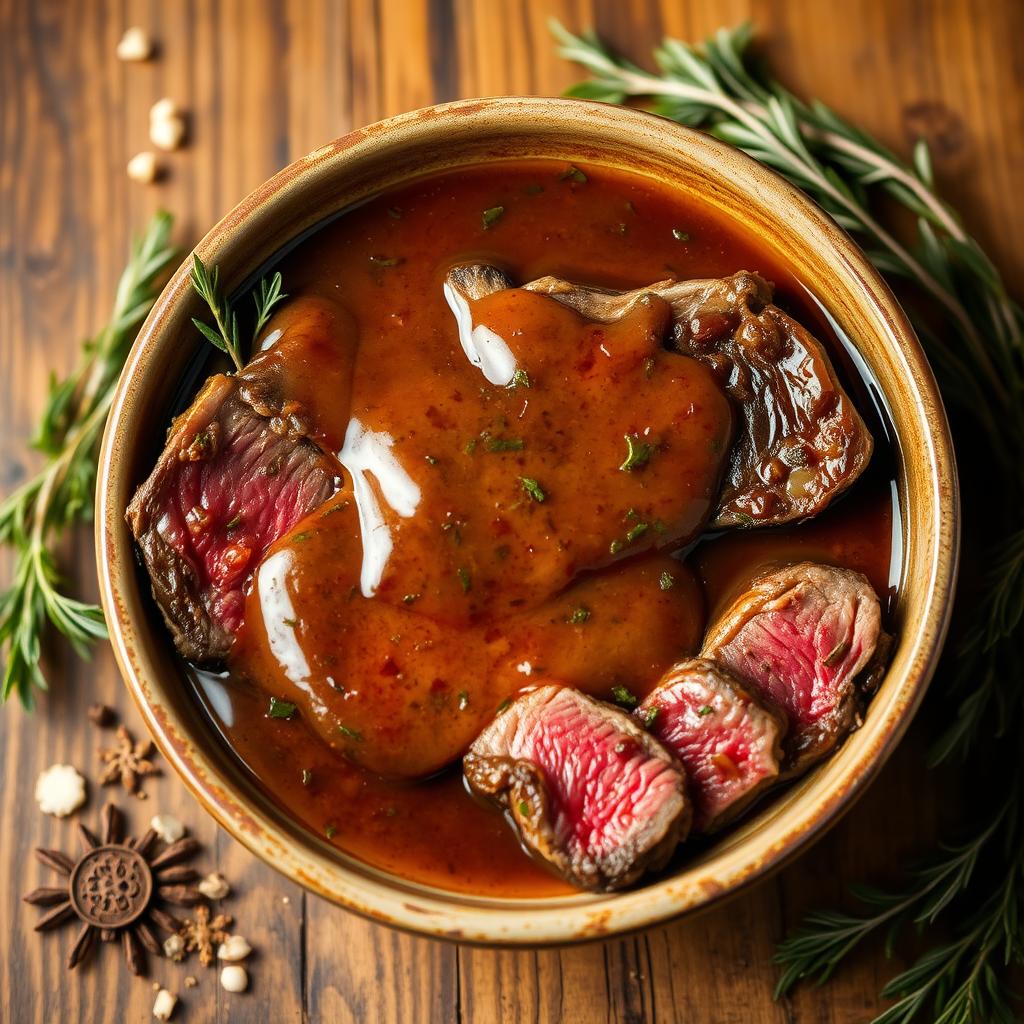
Classic Gravy Recipe
Making a classic ribeye roast gravy is a perfect way to highlight your meat. Begin with the juices left in the roast pan. Mix in a little flour to form a roux. Then, gradually mix in beef broth until it’s just right. Add salt and pepper according to your liking.
Unique Sauces to Try
- Horseradish Cream: This sauce mixes sharp horseradish with creamy textures. It offers a striking balance to the ribeye’s rich taste.
- Chimichurri: Coming from Argentina, this herb sauce brings a garlicky punch. It also adds acidity, slicing through the meat’s richness.
- Red Wine Reduction: Simmer red wine with shallots, beef stock, and a hint of thyme. It becomes a glossy glaze that amplifies the ribeye’s flavor.
- Garlic Butter Sauce: A simple mix of melted butter, minced garlic, and parsley. It gives the ribeye a smooth, buttery edge.
Explore various sauces to find the best match for your ribeye. The right choice in ribeye roast gravy and sauces makes your meal stand out.
Serving Suggestions and Side Dishes
A complete roast meal is more than just a well-cooked ribeye. The right sides can lift the whole meal. Here are some tasty suggestions to pair with your roast:
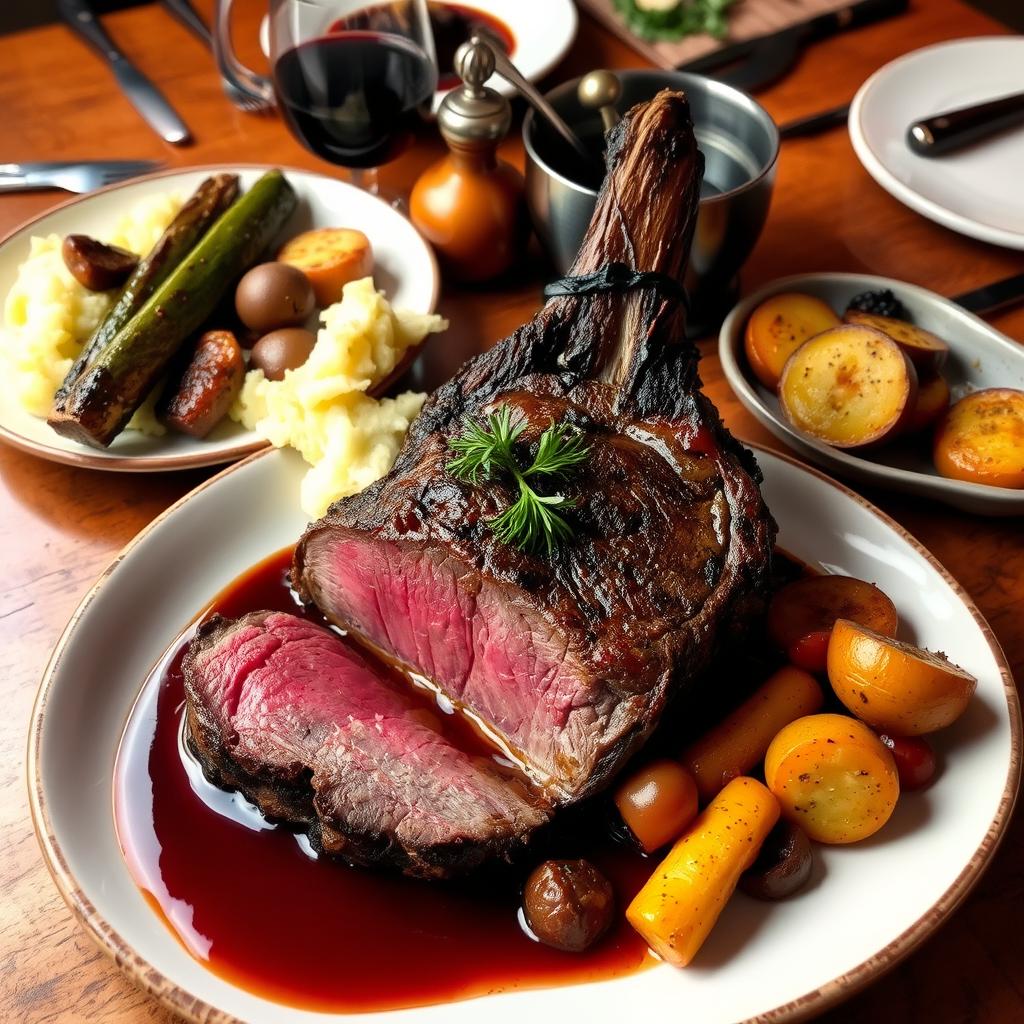
For a truly memorable meal, include a mix of vegetables, starches, and wine. These elements balance and enhance the ribeye’s rich taste.
- Vegetable Sides: Seasonal vegetables make great sides. Try roasted Brussels sprouts, caramelized carrots, or garlic sautéed green beans. They add color and nutrition.
- Starches: Creamy mashed potatoes are a classic with ribeye. Or, try herb-roasted baby potatoes or potato gratin. Wild rice pilaf or cheesy polenta are also great options.
- Wine Pairings: A bold red wine like Cabernet Sauvignon or Merlot suits ribeye’s flavors. For white wine lovers, an oaky Chardonnay is a good match.
Choosing the right sides and wines for your ribeye makes the meal special. It turns dinner into a memorable culinary journey.
Storing Leftover Ribeye Roast
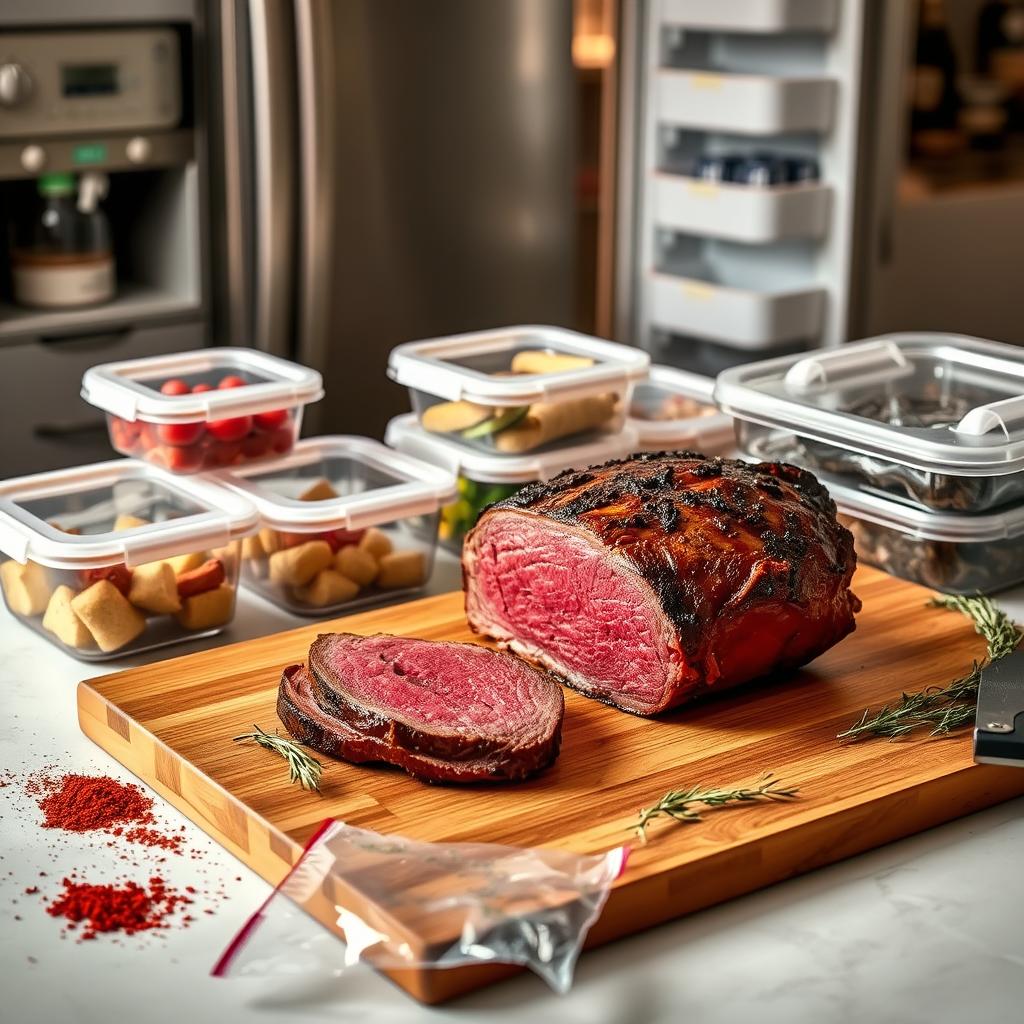
Enjoyed a ribeye roast and have leftovers? It’s important to keep them as tasty as the first time. Use these tips to keep your ribeye leftovers delicious.
Proper Storage Methods
First, cool the ribeye quickly to stop bacteria from growing. Then, cut the roast into smaller pieces for storage.
Use Airtight Containers: Keep the slices in airtight containers or zip-lock bags. This helps keep them moist and flavorful.
Refrigerate Promptly: Put the slices in the fridge within two hours after cooking. They’ll stay fresh for up to three days like this.
Freezer Storage: For longer storage, wrap each piece in foil or plastic wrap. Then, put them in freezer bags. They can be frozen for up to three months.
Reheating Tips for Best Taste
Reheating ribeye right is key to keeping it juicy and tasty. Here are the best ways to reheat your ribeye.
- Oven Method: Warm your oven to 250°F. Put ribeye slices in a dish, cover with foil, and heat for 20-30 minutes. It’ll heat evenly without drying.
- Microwave Method: For a faster way, use a microwave-safe plate, cover, and heat on low for 1-2 minutes. Keep an eye on it.
- Skillet Method: Use medium heat on a skillet with a little oil or butter. Cook the ribeye slices a few minutes on each side until warm.
Stick to these storing and reheating advice. Your ribeye roast will stay tender and full of flavor. Every bite will be as good as the first.
Common Mistakes to Avoid
Making the perfect ribeye roast requires careful attention. Avoiding common errors is crucial for a juicy, flavorful outcome. Here are some mistakes to avoid in ribeye preparation.
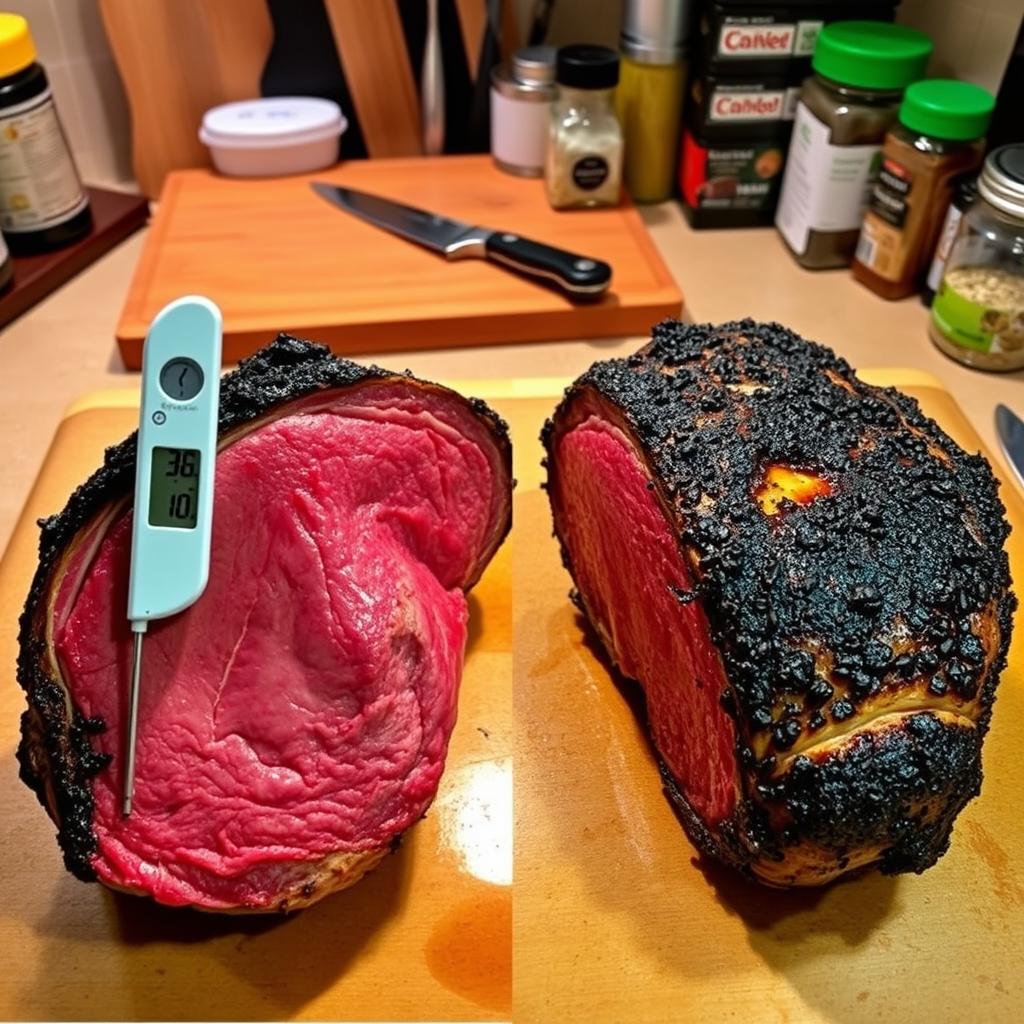
- Choosing the Wrong Cut: Always pick USDA Prime or Choice grades. Good marbling means flavorful meat.
- Skipping the Seasoning: Do not forget to season well. Use salt, pepper, and herbs to enhance taste.
- Improper Cooking Temperatures: Make sure your oven is hot enough before starting. A meat thermometer helps get the right doneness.
- Overlooking Resting Time: Let your roast sit for 15-20 minutes after cooking. It keeps the meat juicy and tasty.
- Incorrect Carving Techniques: Cut against the grain for tender slices.
To make your ribeye roast perfect, avoid these common mistakes. Use these cooking tips to improve your kitchen skills. Serve a memorable roast that everyone will love.
Frequently Asked Questions
Working on the perfect ribeye roast? You might run into a few hurdles. Here are some questions and answers to help you get juicy, tasty results every time.
Why Is My Roast Tough?
A tough ribeye roast can happen for many reasons. The main one is often overcooking. So, make sure to use a meat thermometer to keep an eye on the temperature. Also, picking a cut with good marbling makes it more tender. If your roast is tough, considering these points might help you figure out why.
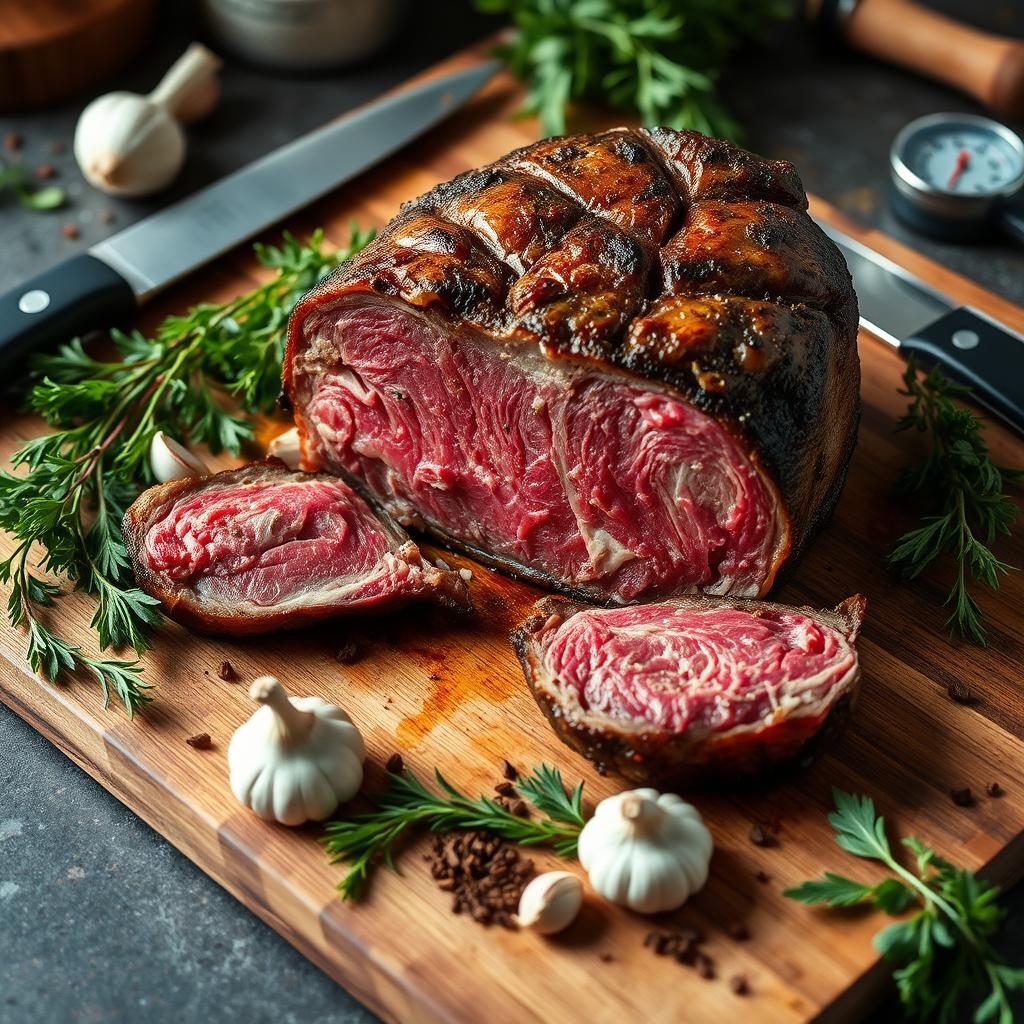
How Can I Ensure Even Cooking?
Getting your ribeye roast to cook evenly is key for a perfect outcome. First, let it sit until it’s room temperature before cooking. This helps the heat spread evenly inside the oven. Always use a meat thermometer to check the temperature while cooking.
To boost your chances of success, think about basting or turning your roast halfway. By doing this, you’ll be more likely to enjoy an evenly cooked, delicious ribeye roast.
Conclusion
We’ve covered every step to make the perfect ribeye roast in this summary. We talked about picking the best ribeye cut and choosing tasty spices and herbs. Also, we learned how to marinate and cook it well.
To make sure your roast is perfect, it’s key to cook it just right. This means getting a crispy crust and keeping the meat juicy. We’ve also learned to cut the roast and choose the best sides and sauces for it. Now, you’re ready to wow your guests.
With the advice from this article, you’re set to make an amazing ribeye roast. Your cooking skills will stand out. Every meal will be memorable. Enjoy the rich flavors and the happiness of sharing a great meal with friends and family.

